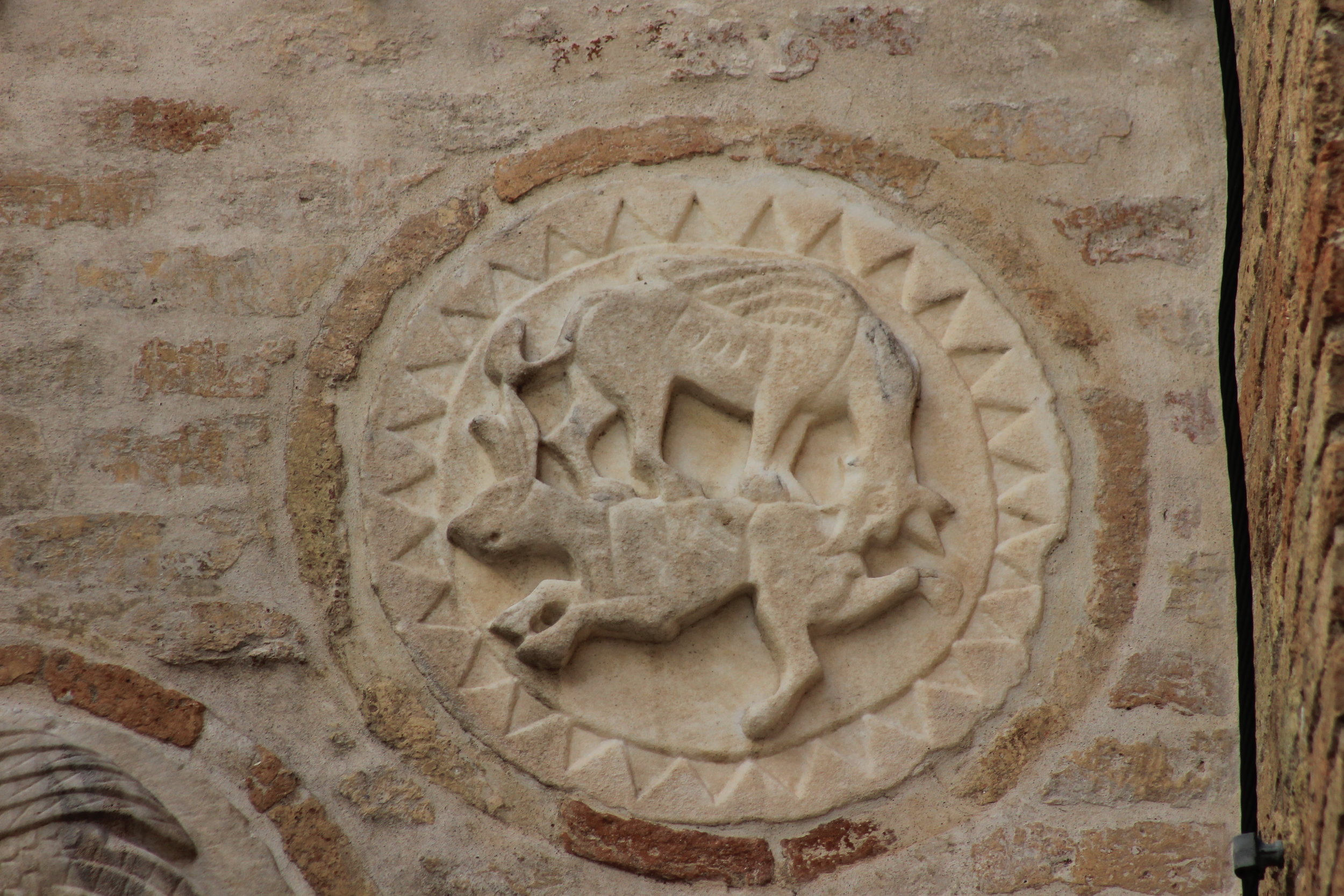Le patere sono bassorilievi di forma circolare tipici della laguna veneta, generalmente poste a ornamento delle facciate civili, benché se ne trovino anche nell'architettura sacra, inclusa la basilica di San Marco. Le formelle sono decorazioni analoghe alle patere, ma di forma rettangolare, spesso con la parte superiore profilata ad arco. Risalgono per la maggior parte al periodo che va dal X al XIV secolo; caddero definitivamente in disuso alla fine del Quattrocento. Conobbero un’importante revival fra Ottocento e Novecento, epoca a cui risalgono numerose imitazioni. Rari sono ormai i contesti in cui si è preservata la distribuzione originaria, dato che un gran numero di edifici fra i più antichi sono stati rimaneggiati o distrutti; peraltro, le patere tuttora esistenti sono abbastanza numerose, poiché venivano costantemente riusate in contesti più recenti, tanto da guadagnarsi il nome di "sculture erratiche". I soggetti ricorrenti sono animali in lotta, mostri ibridi, eroi combattenti, uccelli, fogliami. I tentativi di interpretare queste iconografie sono stati finora sporadici e poco concludenti.
Il chiarimento contestuale offerto dall’arcone marciano e dagli altri archi duecenteschi che sussistono in Venezia può apportare un contributo rilevante all’interpretazione delle patere, che cominciano a individuarsi come insegne di mercanti viaggiatori, poste sulle facciate delle case a indicare percorsi e aree geografiche toccate dalle famiglie.
Poiché patere e bassorilievi con soggetti simili sono diffusi a vasto raggio dal Mediterraneo all’Asia, le indicazioni offerte da queste sculture poste sulle facciate veneziane dovevano risultare a grandi linee comprensibili a un pubblico multiculturale.
Patere are circular bas-reliefs typical of the Venetian lagoon, found mainly on civil buildings, though they also appear on church architecture, including St. Mark’s Basilica.
Formelle are similar to patere, but rectangular, often arch-shaped at the upper edge.
They date mostly from the 10th to the 13th century, and fell into disuse at the end of '400.
Le Patere e l’Arcone Marciano
Patere and St. Mark’s Arch
Trampolieri dai colli intrecciati
Waders with intertwined necks
Patera, secolo XII-XIII / 12th-13th century
Marmo greco / Greek marble
Venezia, Fondamenta della Tana
L’Aquila che piomba sulla preda
The Swooping Eagle
Patera, secolo XII / 12th century
Marmo greco / Greek marble
Venezia, Chiesa di Santa Maria dei Carmini
L’Aquila che si eleva con la preda
The Rising Eagle
Patera, secolo XII / 12th century
Marmo greco / Greek marble
Venezia, Corte Seconda del Milion, Case dei Polo
Credits:
Photos: Lorenzo Peter Castelletto, 2016
Drawings: Bruna Barros
They experienced an important revival in the 19th and 20th century, epoch in which many imitations were produced.
Few are today in their original location, since a large number of the oldest buildings were refurbished or destroyed; rare are now the contexts in which the original distribution is preserved. On the other hand, they survive in good number, as they were constantly reused, which has earned them the name of "erratic sculptures". For this reason, it is often problematic to define the dating of the individual pieces; chronological considerations are mainly based on material and style.
The recurring subjects are fighting animals, hybrid monsters, birds, foliage. Attempts to interpret this iconography so far have been not entirely satisfactory.
The contextual explanation offered by St. Mark’s lower arch, and by other 13th century portals extant in Venice, can give an important contribution to the interpretation of the patere. They now appear as possible emblems of traveling merchants, placed on the facades of houses to indicate routes, or geographical areas touched by the families.
As patere and bas-reliefs with the same subjects are widespread in a vast area, from the Mediterranean to Asia, these sculptures placed on the Venetian facades were possibly readable for a multicultural audience.
Vega, l’ “Aquila che piomba”
patera del secolo XIII conservata in un contesto originale sulla facciata della Ca’ Da Mosto.
La casa risale all’inizio del XIII secolo (il terzo e quarto piano sono aggiunte posteriori), e
prende il nome della celebre famiglia Da Mosto, dinastia di mercanti viaggiatori.
Vega, “The swooping Eagle”
A 13th century patera preserved in an original context on the facade of Ca' Da Mosto. The house
dates from the early 13th century (the third and fourth floors were added later), and is named
after the famous family Da Mosto, dynasty of traveling merchants.
Casa di Italico Brass
Residenza del pittore goriziano (1870-1943), che collocò sui due prospetti la sua collezione
personale di patere originali del XII-XIV secolo, in una disposizione a croce di gusto bizantineggiante;
alcune cornicette in pietra d’Istria non sono originali.
House of Italico Brass
Residence of the painter from Gorizia (1870-1943), who placed his collection of patere on the
two facades, in a cross-shaped arrangement; some of the frames in Istrian stone are not
original.
“L’aquila che si leva” nel contesto di Corte Seconda del Milion
Così chiamata in ricordo dell’opera Il Milione, cronaca dei viaggi compiuti fra il 1271 e il
1295 nell’estremo oriente da Marco Polo. Il padre e gli zii di Marco, mercanti viaggiatori, risiedevano
in queste case adornate da patere, cornici e pilastri
dell’XI-XII secolo.
“The Rising Eagle” in the context of the Corte Seconda of the Milion
A picturesque Venetian courtyard, so called in memory of the book Il Milione, chronicle of the
travels that Marco Polo made in the Far East between 1271 and 1295. Already Marco’s father and
uncles, traveling merchants, lived in these houses, that still are adorned with patere, cornices and pilasters
of the 11th-12th century.
Trampoliere con grosso pesce appeso al becco, altorilievo con bordo a zig-zag e tondini (diam cm. 40 ca.)
Marmo greco, XII secolo. Chiesa di Santa Maria del Carmelo, fianco destro del protiro
Aquila che becca sul capo leporide sottostante in corsa. Altorilievo a modellato quasi piatto e molto aggettante e con bordo decorato a piccoli tondi. Diam cm. 35 ca.
Marmo greco. XII secolo. Chiesa di Santa Maria del Carmelo, fianco destro del protiro.
Grifone che becca sulla coscia leporide sottostante in corsa (modellato piatto con bordo a zigzag) diam. cm 35 ca.
Marmo greco, XII secolo. Chiesa di Santa Maria del Carmelo, fianco destro del protiro.
Aquila che becca sul capo leporide sottostante.
Venice, Rio di Canonica.
Suonatore di flauto su leone. Marmo greco, datazione incerta. sec. X-XIII? diam cm 58 San Marco, facciata nord.
Combattimento fra uomo e leone diam cm 55 Marmo greco, datazione incerta. sec. X-XIII? San Marco, Facciata Nord.
Due leoni controdorso Corte Seconda del Milion
Pavone che fa la ruota Corte Seconda del Milion
Aquila che becca sul capo leporide sottostante; bordo a tondini.
Marmo greco. XII secolo.Diam. cm 30 ca.Chiesa di Santa Maria del Carmelo, fianco destro del protiro.
Due uccelli che intrecciano i colli;
loc. da identificare
Aquila che becca sul capo leporide sottostante. diam. cm 53, 5
Marmo greco, datazione incerta. sec. X-XIII? San Marco, facciata nord
Pavone che fa la ruota diam. cm 51-52
Marmo greco, datazione incerta. sec. X-XIII? diam cm 58 San Marco, facciata nord.













